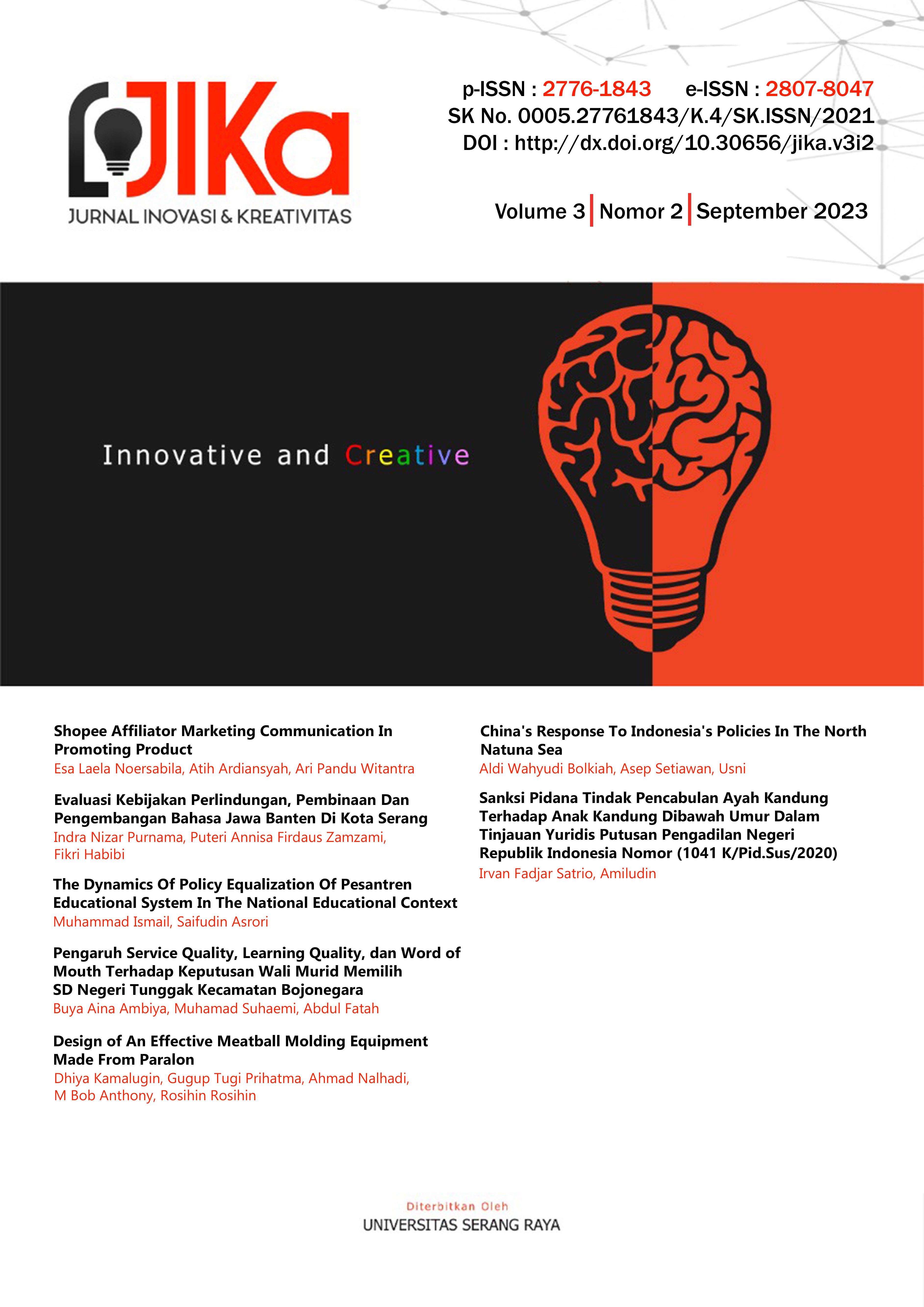China's Response To Indonesia's Policies In The North Natuna Sea
DOI:
https://doi.org/10.30656/jika.v3i2.7084Keywords:
North Natuna Sea, UNCLOS, ZEEAbstract
Problems: The North Natuna Sea has emerged as a point of contention between China and Indonesia. This research delves into the ambiguity and potential conflict within China's response to Indonesia's actions in the region.
Purpose: This research aims to examine China's response to Indonesia's North Natuna Sea policies. And also Investigate Indonesia's policy regarding North Natuna Sea map issuance.
Methodology: Qualitative research methods are employed, primarily involving an extensive review of existing literature. The analysis relies on a descriptive approach, drawing from foreign policy theory and geopolitical theory.
Results/Findings: Indonesia's bold move in 2017, Indonesia officially inaugurated the North Natuna Sea Map. Objectives were clear, demarcate territorial boundaries, maximize resource utilization, and advance maritime ambitions. There is China's Ambiguous Response that took three forms. Coercive Response, China asserted dominance via the controversial Nine Dash Line and military force deployment within Indonesia's Exclusive Economic Zone (EEZ) in the North Natuna Sea. Persuasive Response, Diplomatically, China argued for South China Sea sovereignty, including the Nansha Islands and their waters. President Xi Jinping advocated mutual respect among neighboring countries. Dialogic Response, China engaged in diplomatic dialogues through forums like ASEAN-China Free Trade Area (ACFTA) and ASEAN-China Political Consultative Mechanism (PCM) to reduce regional tensions, seeking mutual agreements.Bottom of Form
Paper Type: Geopolitical Issue
Keywords: North Natuna Sea, UNLCOS, ZEE
Downloads
References
Abduh, M., & Amir, H. (2017). Indonesia-China Trade: Challenges and Opportunities. Jurnal Ekonomi dan Pembangunan Indonesia, 18(2), 103–115.
Abidin, Y. (2019). Pengantar Politik Luar Negeri Indonesia. Jakarta: Lembaga Penerbitan UNAS.
Adam, A. (2019, Agustus 16). Terus Bikin Proyek di Laut Natuna, China Ajukan Klaim Laut Indonesia.
Alfath, T. P., Salman, R., & Sukardi, S. (2020). Derivasi Konsep Negara Kepulauan Dalam Undang-Undang Dasar Negara Republik Indonesia Tahun 1954. Bina Hukum Lingkungan, 4(2).
Ardila, R., & Putra, A. K. (2021). Sengketa Wilayah Zona Ekonomi Ekslusif Indonesia (Studi Kasus Klaim China Atas Laut Natuna). Uti Possidetis: Journal of International Law, 1(3), 358–377.
Azanella, L. A., & Kurniawan, R. F. (2021). Mengenal Natuna, Letak dan Potensi Kekayaan Alamnya Artikel ini telah tayang di Kompas.com dengan judul "Mengenal Natuna, Letak dan Potensi Kekayaan Alamnya.
Baylon, P. B. A., Adi, O. B., Aiko, L., Silalahi, I. R., Sitanggang, S. H., Al Ghifari, D. N., … Saepudin, E. (2021). KAJIAN VALIDITAS KLAIM CHINA ATAS WILAYAH LAUT CINA SELATAN INDONESIA. Jurnal Kewarganegaraan, 5(2), 691–700. https://doi.org/10.31316/jk.v5i2.1986
BRIN. (2021, September 18). Masalah Keamanan Laut China Selatan dan Laut Natuna Utara: Bagaimana Seharusnya Indonesia Menanggapi?
Dharmaputra, M. M. (2013). Dinamika Politik Luar Negeri Indonesia: Sebuah Analisis Kontemporer. Surabaya: Cakra Studi Global Strategis (CSGS).
Djalal, H. (1990). Politik Luar Negeri Indonesia dalam Dasawarsa. Jakarta: CSIS.
Djuyandi, Y., Illahi, A. Q., & Aurel, A. C. (2021). Konflik Laut China Selatan Serta Dampaknya Atas Hubungan Sipil Militer di Asia Tenggara. Jurnal Ilmiah Muqoddimah: Jurnal Ilmu Sosial, Politik dan Hummanioramaniora, 5(1), 112.
DPD. (2015). Sistem Perekonomian Nasional.
Ernandi, S. (2017). Analisis Claim Nelayan Tiongkok Atas Traditional Fishing Ground Di Perairan Natuna. JUSTITIA JURNAL HUKUM, 1(2). https://doi.org/10.30651/justitia.v1i2.1166
Fitriyanto, R. (2020). Indonesia - China Cooperation in Maritime Security: Issues, Challenges and Prospects. Jurnal Hubungan Internasional, 8(1), 18–27.
Haushofer, K. (1942). Geopolitik des pazifischen Ozeans. Zeitgeschichte, 12(3), 145–155.
Hayton, B. (2014). The South China Sea: the struggle for power in Asia. New Haven. New Haven: Yale University Press.
Hendrajit, H. (2017). Pergeseran Sentral Geopolitik Internasional dari Heartland ke Asia Pasifik. Data . Jurnal Kajian Lemhannas RI, 5(1), 31–41.
Holsti, O. R. (1969). Book Review: International Politics and Economics: Theory of International Relations: The Crisis of Relevance. International Journal: Canada’s Journal of Global Policy Analysis, 24(2), 386–388. https://doi.org/10.1177/002070206902400219
Husna TR, C. A. (2018). Strategi Penguatan Pengelolaan Bersama Minyak dan Gas Bumi di Wilayah Laut. Jurnal Konstitusi, 15(1), 140. https://doi.org/10.31078/jk1517
Majumdar, M. (2021). Beijing Raising the Ante in the Natunas: The Next Flash Point in the South China Sea? India Quarterly: A Journal of International Affairs, 77(3), 462–478. https://doi.org/10.1177/09749284211027249
Marihandono, D. A. (2019). Sejarah Wilayah Perbatasan Kepulauan Natna. Jakarta: Direktorat Sejarah, Direktorat Jenderal Kebudayaan, Kementerian Pendidikan dan Kebudayaan Republik Indonesia.
Maulia, E. (2020). Jokowi vows “no compromise†on Natuna standoff with China.
Mazarr, M. J. (2015). Mastering The Gray Zone: Understanding A Changing Era Of Conflict. Pennsylvania: US Army War College Press.
Modelski, G. (1962). A Theory of Foreign Policy. New York: Praeger.
Riyadi, R. A. D. A. (2019). Pemutakhiran Peta di Kawasan Laut Natuna Utara Sebagai, Langkah Indonesia Menjadi Poros Maritim Dunia. Belli Ac Pacis, 5(1), 18–30.
Roosinda, F. W. (2021). Metode Penelitian Kualitatif. Yogyakarta: Zahir Publishing.
Rosenau, J. N. (1969). International Politics and Foreign Policy: A Reader in Research and Theory (J. (N) Rosenau, Ed.). London: Free Press of Glencoe.
Rudiantara. (2020, Januari 4). Penjelasan Sikap Indonesia Atas Penangkapan Kapal Ikan China.
Sambogo, A. (2019). Penamaan Laut Natuna Utara Oleh Pemerintah Indonesia Dalam Perspektif Hukum Internasional. Jurist-Diction, 1(2), 381.
Santoso, P. S. (2021). Percaturan Geopolitik Kawasan Laut China Selatan. Yogyakarta: Deepublish Publisher.
Santoso, T. I. (2020). Aksi Agresivitas Cina Pada Zona Ekonomi Eksklusif Indonesia Laut Natuna Utara: Perspektif Tugas Pokok TNI. Jurnal Lemhannas RI, 8(1), 34–46.
Satow, S. E. (1998). Satow’s Guide to Diplomatic Practice (5 ed.). London: Longman Publishing Group.
Setiawan, A. (2022). Analisis Hubungan Antara Utang Luar Negeri Dan Politik Luar Negeri Indonesia . Seminar Nasional Penelitian LPPM UMJ, 1–11.
Setiawan, A. N. (2020). Diplomasi Maritim Indonesia Dalam Menjaga Kedaulatan Kepulauan Natuna 2014-2019. Jakarta: UM Jakarta Press.
Sugiyono. (2013). Metode Penelitian Kuantitatif, Kualitatif Dan R & D. Bandung: Penerbit Alfabeta.
Suradinata, E. (2001). Geopolitik Dan Geostrategi Dalam Mewujudkan Integritas Negara Kesatuan Republik Indonesia. Jurnal Ketahanan Nasional, 6(2), 79–97.
Wilkenfeld, J., Hopple, G. W., Rossa, P. J., & Andriole, S. J. (1981). Foreign Policy Behavior. The Interstate Behavior Analysis Model. By Jonathan Wilkenfeld, Gerald W. Hopple, Paul J. Rossa, and Stephen J. Andriole. (Beverly Hills, Calif.: Sage Publications, 1980. Pp. 288. $22.50.). American Political Science Review, 75(3), 756–757. https://doi.org/10.2307/1960986

.png)


.png)


.png)

.png)

